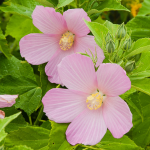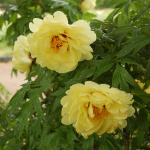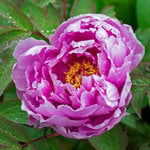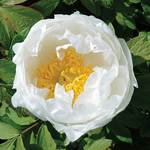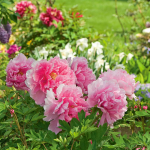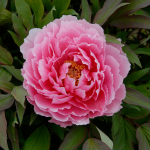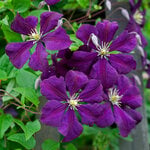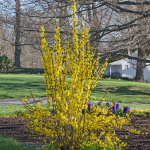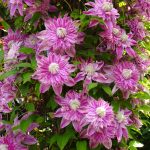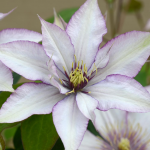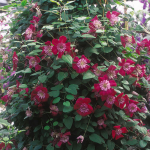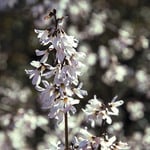Product Details
Paeonia suffruticosa 'Shikounishiki' features ruffled, satiny purple-red petals surround bright yellow centers. It takes a few seasons for this Tree Peony's blossoms to reach their full potential, but you will be amply rewarded for your patience.
The genus Paeonia includes more than 30 species with plants native to Europe, Asia, and western North America. The majority are perennials that die back year to year (Herbaceous Peonies), while some are woody shrubs (Tree Peonies). There is also a group of hybrids created by crossing Herbaceous and Tree Peonies (Itoh/Intersectional Peonies). Peonies flower in mid- and/or late spring with blossoms appearing in a variety of forms, from delicate Singles to petal-packed Doubles. These long-lived, carefree plants are classic elements of borders and beds. They combine beautifully with a wide array of perennials. When Peony blossoms subside, their cut-leaf foliage and mounding forms continue to bring beauty and structure to the garden while flattering and supporting neighboring plants. The flowers of Herbaceous and Itoh Peonies are outstanding in bouquets.
Tree Peonies are not actually trees but, rather, woody shrubs that flower in mid-spring, ahead of Herbaceous and Itoh Peonies. Cultivated for centuries, they are treasured, collected, and revered for their magnificent and multitudinous blossoms. Today’s hybrids (the best known being those of Paeonia suffruticosa) are descendants of about 10 species native primarily to China. The silken flowers range in size from a few inches in diameter to 9” or more. Mature plants may produce as many as 50 blossoms in a single season. Flower colors include various shades of white, pink, red, lavender, and yellow. Distinct from Herbaceous and Itoh Peonies, the stems of Tree Peonies remain above ground during winter. They resprout in spring and do not require pruning except minimally for shaping or to remove dead stems. The deeply divided foliage remains green throughout the growing season, forming an attractive background for neighboring plants. Long-lived Tree Peonies thrive in morning sun with dappled shade in the afternoon. Late-day shade is required in gardens in the South and warm areas of western Zone 9.
For more information on Tree Peony care, click Growing Guide.
Shipping
HOW PLANTS ARE SHIPPED
The size of the plants we ship has been selected to reduce the shock of transplanting. For some, this means a large, bareroot crown. Others cannot travel bareroot or transplant best if grown in containers. We ship these perennials and annuals in 1 pint pots, except as noted. We must point out that many perennials will not bloom the first year after planting, but will the following year, amply rewarding your patience. We ship bulbs as dormant, bare bulbs, sometimes with some wood shavings or moss. Shrubs, Roses, vines, and other woody plants may be shipped bareroot or in pots. The size of the pot is noted in the quick facts for each item.
WHEN WE SHIP
We ship our bulbs and plants at the right time for planting in your area, except as noted, with orders dispatched on a first-come, first-served basis by climate zone. We also ship a wide range of containers and planters, tools, supplies, fertilizers, garden wear, garden decor items, as well as indoor decorations like wreaths and dried bouquets when available. Estimated dates for shipping are indicated in the green Shipping Details box for each item. Please supply a street address for delivery. Kindly contact us with two weeks notice, if you'll be away at the expected time of delivery.
OUR GUARANTEE
We guarantee to ship plants that are in prime condition for growing. If your order is damaged or fails to meet your expectations, we will cheerfully replace or refund it. Please contact our Customer Service Department at 1-800-503-9624 or email us at [email protected]. Please include your order number or customer number when contacting us.
Reviews
There are no reviews yet. Be first to Write a Review.
Growing guide
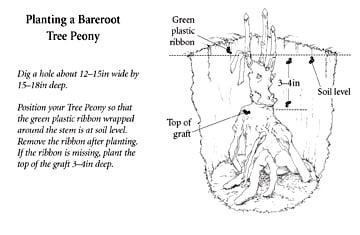
Latin Name Pronunciation: pee-oh'nee-uh suf-root-ih-ko'suh
Tree Peonies are magnificent, long-lived woody shrubs that no garden should be without. Some varieties reach 4–5′ in height and plants are capable of bearing fragrant flowers to 10″ in diameter. Tree Peonies thrive in areas with cold winters and hot summers and do very well in the Northeast and Midwest, and are hardy from Zones 4 to 8. Gardeners in Zone 9 can enjoy Tree Peonies by forcing the shrubs into dormancy: trim off all foliage in November, leaving the woody stems, do not water or fertilize, and with luck the plant will form flower buds.
Tree Peonies are not plants for the impatient gardener, as they may take 3 years to become established and flower. Bear in mind, also, that the flowers of a new plant may not reach their potential for several seasons. That said, there is absolutely nothing like a Tree Peony in full bloom; such a sight is breathtaking.
Tree Peonies need some time to settle in before they bloom; it's not unusual for a plant to wait until its third spring before it flowers. In addition, Tree Peonies are often slow to break dormancy the first spring after planting. Your plant may look dead while its neighbors are springing to life, but it will awaken soon enough.
Light/Watering: Light shade from hot afternoon sun is necessary to protect the flowers, and in China and Japan small parasols are set over the plants to block the sun. Plant Tree Peonies where they will be protected against drying winds in summer and winter. Tree Peonies are very drought tolerant once established. Do not overwater and do not plant near an automatic irrigation system. Wait until the soil has dried down to 4″ before watering deeply. Watering too much will kill the roots and is a common reason for failure.
Fertilizer/Soil and pH: Tree Peonies need a well-drained soil with a pH close to neutral or a bit above. If your soil is acidic, add a few handfuls of lime at planting time. Plant at the depth indicated by the green plastic ribbon wrapped around the main stem, and remove the ribbon after setting the plant at the right depth. If the ribbon has gone astray, plant the top of the graft union (which appears as a bulge on the main stem) about 4–6″ below the surface of the soil to encourage the scion to form its own roots. Topdress plants in spring with an inch of compost or aged manure. A foliar feeding with fish emulsion is appreciated during the growing season.
Pests/Diseases: On rare occasions you may notice a hole in the woody stem, caused by a boring insect. You may be able to kill the larva in the tunnel using a thin wire, or simply cut out the affected area. Like Herbaceous Peonies, Tree Peonies are occasionally afflicted with fungal diseases that cause black spots on leaves and wilting of shoots. Remove any diseased foliage as soon as noticed and be sure to clean up all fallen plant parts in the autumn. If fungal diseases become a problem, spray with a fungicide early in spring, repeating the treatments for several weeks. Be diligent with deadheading and do not allow fallen petals to remain caught in the plant or on the ground.
Companions: Hellebores , Alchemilla, Leucojum, Epimedium and Siberian Irises are all lovely in combination with Tree Peonies. If your plants tend toward legginess, underplant with spring-flowering bulbs.
Pruning: Never prune Tree Peonies back to the ground as is done with their herbaceous relatives. Prune out any damaged or broken stems after plants leaf out. Once your plant has some age and is growing vigorously, you may want to open up the center a bit to encourage flowering on the taller stems and increase air circulation. Tree Peonies are grafted onto Herbaceous Peony roots and occasionally a shoot from the rootstock will arise from the base of the plant. These should be removed immediately.
Dividing/Transplanting: Tree Peonies do not need to be divided, and with many plants this is impossible. Young plants may be moved when dormant; dig the plant keeping as much soil around the roots as possible.
End-of-Season Care: Remove all foliage after a killing frost, including leaf petioles; discard away from your garden area, not in the compost pile. New plants should be mulched, and in the coldest areas should be wrapped with burlap or another material to protect from winter winds.
Calendar of Care
Early Spring: Topdress plants with an inch of compost or aged manure. Watch for signs of fungal disease and treat as needed. If a shoot arises from the rootstock, remove it.
Mid-Spring: Some varieties may need support for the heavy flowers. If the interior of the plant is crowded with foliage, thin it out to improve air circulation.
Late Spring: Do not overwater. Be diligent with deadheading spent blossoms and remove old flowers and petals from the garden.
Summer: Only water plants when soil dries out to a depth of four inches, and then water deeply. Foliar feeding with fish emulsion is appreciated.
Fall: Do not prune Tree Peonies back; they are woody shrubs. Remove all foliage after frost, but do not compost. Mulch new plants and those grown in the colder zones, and if cold winter winds are expected, wrap plants with burlap or other protective material.

